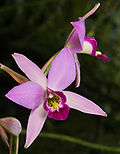| Image | Name | Distribution | Elevation (m) |
|---|
 | Laelia albida Bateman ex Lindl. 1839 | Mexico | 1,000–2,000 metres (3,300–6,600 ft) |
 | Laelia anceps Lindl. 1835 | Mexico and Honduras | 500–1,500 metres (1,600–4,900 ft) |
| Laelia aurea A.Navarro 1990 | Mexico ( Durango, Sinaloa and Nayarit ) | 200 metres (660 ft) |
 | Laelia autumnalis (Lex.) Lindl. 1831 | Mexico | 1,500–2,600 metres (4,900–8,500 ft) |
 | Laelia colombiana J.M.H.Shaw 2008 | Colombia and Venezuela | |
 | Laelia elata (Schltr.) J.M.H.Shaw 2009 | Colombia | |
| Laelia eyermaniana Rchb.f. 1888 | Mexico (Nayarit, Michoacán, and Jalisco, Sonora, Chihuahua, Durango, Guanajuato, and Querétaro. Halbinger) | 1,600–2,600 metres (5,200–8,500 ft) |
 | Laelia furfuracea Lindl. 1839 | Mexico (Oxaca) | 2,100–3,000 metres (6,900–9,800 ft) |
| Laelia gloriosa (Rchb.f.) L.O.Williams 1860 | Guyana, Venezuela, Colombia, Ecuador and northern Brazil | 200–850 metres (660–2,790 ft) |
 | Laelia gouldiana Rchb.f. 1888 | Mexico Hidalgo | 1,550 metres (5,090 ft) |
| Laelia × halbingeriana Salazar & Soto Arenas | Oaxaca, Mexico | 1,160 metres (3,810 ft) |
| Laelia heidii (Carnevali) Van den Berg & M.W.Chase 2004 | Colombia and Venezuela | |
 | Laelia lueddemannii (Prill.) L.O.Williams 1940 | Costa Rica, Panama, Colombia and Venezuela | 0–600 metres (0–1,969 ft) |
| Laelia lyonsii (Lindl.) L.O.Williams 1941 | Cuba and Jamaica | 0–800 metres (0–2,625 ft) |
 | Laelia marginata (Lindl.) L.O.Williams 1941 | Colombia, Venezuela, French Guiana, Guyana, Suriname and Northern Brazil | |
| Laelia mottae Archila, Chiron, Szlach. & Pérez-García 2014 | Guatemala | 400 metres (1,300 ft) |
| Laelia moyobambae (Schltr.) C.Schweinf. 1944 | Bolivia and Peru | |
| Laelia rosea (Linden ex Lindl.) C.Schweinf. 1967 | Colombia, Venezuela and Guyana | |
 | Laelia rubescens Lindl. 1840 | Mexico, Guatemala, Belize, El Salvador, Honduras and Nicaragua | 0–1,700 metres (0–5,577 ft) |
| Laelia schultzei (Schltr.) J.M.H.Shaw 2008 | Colombia | |
 | Laelia speciosa (Kunth) Schltr. 1914 | Mexico | 1,400–2,400 metres (4,600–7,900 ft) |
 | Laelia splendida (Schltr.) L.O.Williams 1941 | Colombia and Ecuador | 600–1,500 metres (2,000–4,900 ft) |
 | Laelia superbiens Lindl. 1840 | Mexico, Guatemala, Honduras and Nicaragua | 800–2,000 metres (2,600–6,600 ft) |
 | Laelia undulata (Lindl.) L.O.Williams 1941 | Costa Rica, Panama, Colombia, Peru, Trinidad, Venezuela | 600–1,200 metres (2,000–3,900 ft) |
| Laelia weberbaueriana (Kraenzl.) C.Schweinf. 1944 | Peru and Bolivia | 200–1,300 metres (660–4,270 ft) |
|















